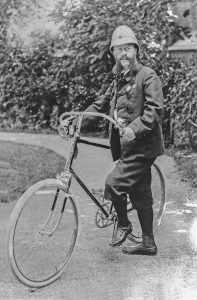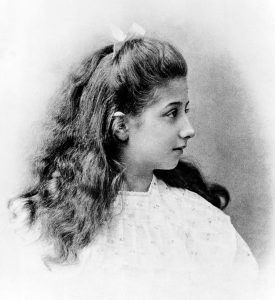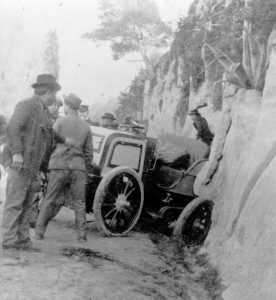The so-called Belle Epoque between 1880 and the outbreak of WWI was a period of prosperity that had not been paralleled before. It created a proactive climate in which new technologies and trends concurred. A person that was to make himself a name in that time was Emil Jellinek. Born in 1853 in Vienna, Austria he made his fortune as a businessman and diplomat. He — like many other people in those years — had developed a taste for speed. This led to his interest in bikes or velocipedes as they were called back then. What could be achieved with these vehicles was still very much limited by muscular power, in this case Jellinek’s own strength.

Meanwhile the combination of Wilhelm Maybach’s constructive ingenuity and Gottlieb Daimler’s entrepreneurial spirit had brought the combustion engine to another level of effectiveness. Making it fast running and compact had allowed to install the first engine in vertical orientation they had built to be installed in many different vehicles. They continued striving to power vehicles with new innovations and this is where the thread reconnects with Emil Jellinek.
Having owned automobiles before and his first combustion engine vehicle being a Benz Victoria, he discovered the products of the Daimler-Motoren-Gesellschaft (Daimler Motors Corporation) in 1897. Not only did he buy a belt driven car, but he also became an independent seller of the products made in Canstatt not much later. Having a circle of affluent contacts in Nice, his clients included names such as Henri and Arthur de Rothschild. In the course of time, he greatly contributed greatly to the company’s success with orders worth up to 500.000 Goldmarks, huge sums for the time.

Jellinek had been very keen in participating in races. He also loved all things Spanish (he spoke the language fluently as well). This might have been the reason why he dedicated his daughter’s first name as a pseudonym for the cars that took part on his behalf — Mercédès Adrienne Ramona Manuela Jellinek who had been born in 1889. In March 1900 a tragic accident happens during the race of Nizza. Wilhelm Bauer, a company driver of the Daimler-Motoren-Gesellschaft hits a wall and loses his life. The phoenix car which he had been driving under the name Mercedes II design-wise still owed a lot to carriages. It quickly became clear that it was not optimal for racing. Jellinek ordered a new type of vehicle that was to withstand the demands better. An agreement for the production of a more powerful and lighter engine was made in April 1900 between DMG and Jellinek. It was to be named Daimler-Mercedes.

The developments that Wilhelm Maybach made in this project were to be an essential stepping-stone for the modern automobile. A lower point of gravity, a longer wheelbase, were aspects that made the car more stable on the road. Wilhelm Maybach also contributed greatly to the engines performance by adding the so-called honeycomb cooler. It cooled the engine more efficiently than all earlier types of development. Already in December 1900 the first Mercedes car, the Mercedes 35 PS is delivered to Jellinek. During the week of Nice in March 1901 the car performs very well across different disciplines and achieves unparalleled successes. Paul Meyan, the president of the French automobile club coins it not much later ‘We have entered the Mercedes era.’. The serial versions based on the Mercedes 35 PS, the Mercedes Simplex, became a global success.

The legacy of this extraordinary cooperation also materialized in an object that seems like an eyewitness in itself. Wilhelm Maybach received a golden stop pocket-watch from Emil Jellinek to thank him for his contributions without which the success of the name Mercedes had never been possible. It was then passed on by him to his son Karl who perpetuated the excellence of the name Maybach in car construction. With this year not only seeing the 120 year anniversary of the successes of the first Mercedes cars in Nice, but also the 100 year anniversary of the Maybach cars made in Friedrichshafen, we will get back to this legendary watch in the course of this year – stay tuned.


